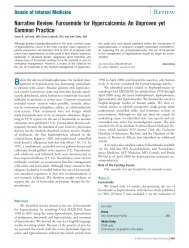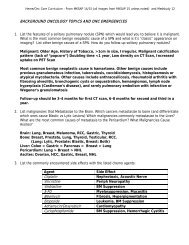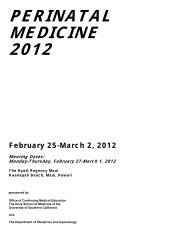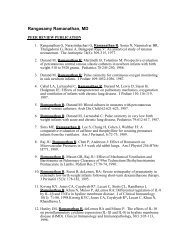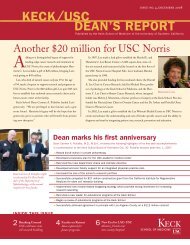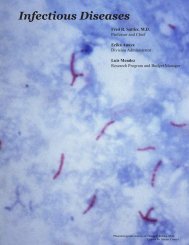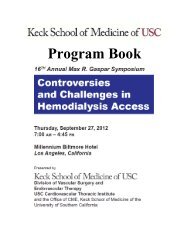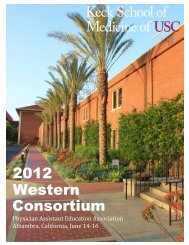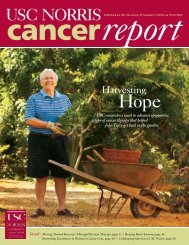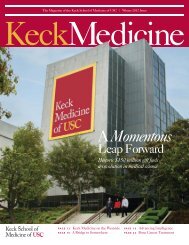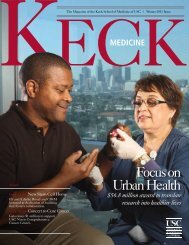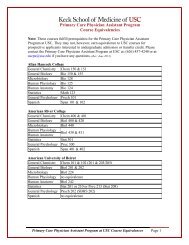Arrhythmogenic Right Ventricular Dysplasia/Cardiomyopathy
Arrhythmogenic Right Ventricular Dysplasia/Cardiomyopathy
Arrhythmogenic Right Ventricular Dysplasia/Cardiomyopathy
You also want an ePaper? Increase the reach of your titles
YUMPU automatically turns print PDFs into web optimized ePapers that Google loves.
<strong>Arrhythmogenic</strong> <strong>Right</strong> <strong>Ventricular</strong><strong>Dysplasia</strong>/<strong>Cardiomyopathy</strong>Roshni Shah PGY 2University of Southern CaliforniaDepartment of Medicine
OutlineIntroductionDescription of the CaseDiscussioniCase Re-visited
Learning ObjectivesCharacteristics of ARVCEpidemiologyPresentation and symptomsRadiographic findings consistent with ARVCDiagnosis/Management
Introduction<strong>Arrhythmogenic</strong> <strong>Right</strong> <strong>Ventricular</strong><strong>Dysplasia</strong>/<strong>Cardiomyopathy</strong> (ARVC) is an inheritedautosomal dominant conditionCharacterized by progressive fibrofatty involvement ofright ventricular myocardiumHeterogenous structure of RV myocardium predisposesto Congestive Heart Failure, <strong>Ventricular</strong> Tachycardiaand Sudden Cardiac DeathCase depicts: dp ARVC in middle age female with initialfindings of <strong>Ventricular</strong> Tachycardia and Left<strong>Ventricular</strong> involvement
Case PresentationChief Complaint: Increased neck pressure withvomiting and syncopeHPI: 51 year old Cantonese female with no pastmedical history that initially presented with history ofacute palpitations associated with a syncopal episode.She first presented to an outside hospital complainingof chest pressure followed by a syncopal episode. Shehad a troponin leak and a positive stress test revealingsmall inferolateral wall infarct and anterior wallischemia.
Past MHx: none except normal cardiac cath 3 wks priorPast Surgical Hx: noneSocial Hx: No Etoh, tobacco or drugs. Lives withfamily. From China and works in a factoryFHx: No history of sudden cardiac death, no history ofheart disease. Father died d of fllung cancerAll: NKDAHome Meds: Benazpril 5mg, Coreg 3.125mg BID,Zocor 20mg, ASA 81mg, and NTG SL 0.4mg PRN
Physical ExamVitals: Temp 96.7, BP 85/58, HR 152, RR 22, ,ppulse ox97-100%Gen: Initially speaking complete sentencesHEENT: N/C, A/T, EOMI, mucous membranesmoist, no icterusNeck: No mass, no JVDHeart: RRR +s1 +s2, no murmurs/rubs/gallops. PMInon-displaced, + tachycardiaLungs: CTAB, no wheezingAbd: thin, soft, no rebound/garuding/rigidityLow ext: no edema +2 pulses
EKG at Presentation in ER
Wide Complex Regular Tachycardia+ QRS II, III, aVFLBBB MorphologyHigh to low and right to left ventricular activation= RVOT Tachycardia
ER CourseEKG: Sustained V-TachsTachs, with RVOTmorphology (LBBB pattern with inferiordirected axis), <strong>Ventricular</strong> rate 160-180180beats/min.Patient cardioverted 5 times (100J, 150J, and 3times 200J) with recurrence after each successfulcardioversionStarted intravenous amiodarone, eventuallyconverted to sinus rhythmTransferred to CCU for further evaluation.
LabsTroponins: 0.120.21.3 2.20 1.89 1.53 1.26BMP: Na 142, K 4.6, Cl 105, CO2 24, BUN 21, Cr 0.98, glu 132TSH 4.90, Free T4 1.19CBC: hgb 13.1, hct 38.3, WBC 9.4, platelet 230Lipid panel: 131/66/61/57PT: 15.5, INR 1.18, PTT 27.8
Chest X-Ray
CCU CourseContinued on amiodarone gtt, with constantmonitoring of cardiac rhythmSinus rhythm with occasional PVC’sTTE (this admission): Mid-Distal mild hypokinesis ofleft ventricle with a thin apicoseptal p aneurysm. No clot.LV function moderately depressed with estimated EF40%. RV moderately dilated, RVSP 30-35mmHg 35mmHg andmoderate TR.EP consulted and recommend cardiac MRI
EKG after cardioversion on amiodarone gtt
Cardiac MRIRevealed right ventricle dilatation with focal wallmotion abnormalities, scalloped end-systoliccontour, deep trabeculations, prominentintramyocardial fat, and patchy right ventriculardelayed gadolinium enhancement.Left ventricle has EF 33.4%, focal, nonvascularterritory wall motion abnormalities of the basilarinferior i wall and apical lateral l wall and patchyareas of late gadolinium enhancement.
Cardiac MRI4 chamber viewdemonstrating rightventricular enlargement,segmental dilatation ofthe right ventricular freewall and prominenttrabeculation (arrow) ofright ventricle.
Cardiac MRIShort axis viewdemonstrating lategadolinium enhancementof the left ventricularmyocardium
Cardiac CTNon contrast CTdemonstrating decreasedattenuation of the rightventricular wallconsistent with fattyinfiltration i of themyocardium.
Final OutcomeEvaluated by EP, s/p ICD placement andremained in sinus rhythm throughout CCUcourse. Initially on amiodarone gtt and thenconverted to PO regimenDischarged home on low dose amiodarone andremained chest pain and palpitation free
DiscussionARVC is a genetic diseaseMutations affect genes coding desmosomal proteinsPrimary function is forming intercellular junction andcell adhesion; disruption leads to cell death and tissueremodelingCharacterized by structural and functional abnormalitiesiof right ventricle, fibro-fatty fatty and scar tissue replacementresults in ventricular tachycardia, RV failure or suddencardiac death20% of SCD among young individuals
Mechanical Stress on impaired desmosomalproteins Myocyte detachment and death
Gross Anatomy
Coronary Syndrome XPatients have angina symptoms without CADCommon in females after menopausePresent with positive stress test, but negative cathStructurally normal myocardiumPossible Etiologies:– Microvascular angina, tightening of small blood vessels inheart leading to angina, but too small to cause infarction– Enhanced pain perception, “hypersenstivity” to cardiac painDiagnosis of exclusion
<strong>Right</strong> <strong>Ventricular</strong> Outflow Tract<strong>Ventricular</strong> Tachycardia10% of all <strong>Ventricular</strong> Tachycardias, major differential in patientswith LBBB morphology with inferior axisBenign process in absence of structural heart diseaseElectrical defect that results in ventricular extra beats orsustained tachycardiaPresents with palpitationsProposed mechanism: cAMP triggered activity, resulted fromintense exerciseDiagnosis s of exclusion, and ARVC must be ruled outRVOT do not usually have EKG changes associated with ARVCLong term prognosis is good, and SCD is rare
History/EpidemiologyNewly recognized disease, clinical profile first publish in1982Autosomal dominant with penetrance in family members25-30% and 50% in Northern region of Italy.Exact incidence and prevalence is unknown, estimated1:5000– One group of patients diagnosed based on symptoms, EKGchanges and arrhythmias– Other group of clinically silent disease and asymptomatic untilthey manifest as sudden cardiac death– Pt that with CHF where dysplasia was not considered can bemistakenly diagnosed for idiopathic dilated cardiomyopathy
EpidemiologyUsually manifest young age (2 nd and 3 rd decades)Common cause of SCD during sports participationAccounts for 5-11% causes of SCD in age
Diagnosis: Task Force CriteriaI. Global and/or regional dysfunction and structural alterationsMajor:– Severe dilatation and reduction of right ventricular ejectionfraction with no (or only mild) LV impairment– Localized right ventricular aneurysms (akinetic or dyskineticareas with diastolic bulging)– Severe segmental dilatation of right ventricleMinor:– Mild global RV dilatation and/or EF reduction with normalLV– Mild segmental dilatation of RV– Regional RV hypokinesia
II. Tissue characterization of wallMajor:– Fibrofatty replacement of myocardium on endomyocardialbiopsyIII. Repolarization abnormalitiesMajor:– Inverted T waves in right precordial lead (V2 and V3) inpeople aged >12 years, in absence of RBBB.IV. Depolarization/Conduction AbnormalitiesMajor:– Epsilon waves or localized prolongation (>110ms) of theQRS complex in right precordial leads (V1-V3) V3)Minor:– Late potentials (signal-averaged averaged ECG)
Epsilon waves,which h arereproduciblesmall deflectionsseen just beyondthe QRS complexin lead V1 or V2.T wave inversion beyond lead V1
<strong>Right</strong> ventricular parietalblock as evidenced by aQRS durationin V1 + V2 + V3 that islonger than that in leadsV4, V5, V6 by a ratio of 1:2
V. ArrhythmiasMinor:– LBBB type ventricular tachycardia (sustained andnonsustained) by EKG, Holter, or exercise testing– Frequent ventricular extrasystoles (>1000/24 hours) (Holter)VI. Family HistoryMajor:– Familial disease of confirmed at necropsy or surgery– Minor:– Family history of sudden death (
DiscussionThree clinical stages:– Initially asymptomatic phase– Followed by structural changes with electrical instability– Leading to global impairment of contractility withsymptomatic heart failureLV lesions associated with more: clinical arrhythmicevents, severe cardiomegaly, and heart failureHigh risk patients (LV involvement, family hx of SCDor syncope where V. fib/V. tach can’t be excluded)need ICD
Evaluation of Risk Factors SCD in ARVCPrevious episodes of cardiac arrestsSyncopeHistory of SCD in family members
<strong>Arrhythmogenic</strong> <strong>Right</strong> <strong>Ventricular</strong> <strong>Dysplasia</strong>: A UnitedStates ExperienceDarshan Dalal et al. Circulation 2005; 112; 3823-38323832Purpose: Describe clinical characteristics and outcomes of a largecohort of ARVD patients in United StatesMethod: Evaluated 100 pts with ARVD, identified from John’sHopkins ARVD registryDiagnosis of ARVD was established by Task Force CriteriaResults:– Presenting Symptoms: Palpitations 27%, Syncope 26%, andDeath 23%– 31 pts experience e SCD, 66 pt alive at follow ow up (44 had ICDplaced, 20 were on medical therapy, 2 transplanted heart)– Autopsy: RV dilatation was moderate to severe in 29%, andmild in 20%
Discussion:– ARVD typically presents between second and fifth decades– Common presenting sxs: palpitations, syncope, and death– Close link between ARVD and SCD– ½ patients presented with malignant or potentially malignantventricular arrhythmias– Important to screen family– Once treated with ICD, good prognosisLimitations: Population composed of 2 subsets of patients:those diagnosed while living and followed prospectively (n=69) and those diagnosed on autopsy (N=31).
ManagementNo curative management for ARVCImportant to risk-stratify patients– Patient with non-life threatening arrhythmia's treatedempirically with anti-arrhythmic mediations– Beta-blocker, sotalol, amiodarone, flecainide, propafenone– Patient with risk of Sudden Cardiac Death are treated withICD placementAdvise patients t to avoid competitive sports, limititphysical activityAdvise treatment with B-blocker as well as ACEinhibitor if tolerated
Genetic TestingFamily ScreeningFamilion ARVC testing: sequences 5 ARVC genes– Patients with clinical features consistent with diagnosis ofARVC– Relatives of patients with known ARVC gene mutationsGoal: Genotyping families with ARVC is to identifyaffected relatives before a malignant or life-threateningarrhythmias occurECG and Cardiac ImagingFor children and adolescents, ,possible re-screening asoften phenotypic presentation does not occur until lateadolescence
Case Re-visitedPatient presents with history of syncope and ventriculartachycardiaMet Task Force Criteria: Dilated <strong>Right</strong> Ventricle,<strong>Ventricular</strong> arrhythmia's, and fatty replacement ofmyocardiumS/p ICD placement, followed up in clinic andcontinues to remain chest pain free
ReferencesMcNally E, MacLeod H, Dellefave L. Arrythmogenic <strong>Right</strong><strong>Ventricular</strong> <strong>Dysplasia</strong>/<strong>Cardiomyopathy</strong>, yp y p y, Autosomal Dominant.GeneReviews [Internet]. Seattle WA: University of Washington,Seattle; 1993-2005 Apr 18 [updated 2009 Oct 13].Wozniak O, Wlodarska EK. Prevention of sudden cardiac deathin arrhythmogenic right ventricular cardiomyopathy: how toevaluate risk and when to implant a cardioverter-deibrillator?Cardiology Journal. 2009; 16(6):588-91. ISSN1897-5593Dalal et al. <strong>Arrhythmogenic</strong> <strong>Right</strong> <strong>Ventricular</strong> <strong>Dysplasia</strong>: AUnited States Experience. Circulation 112 (25):3823.(2005)Marcus et al. <strong>Arrhythmogenic</strong> right ventricularcardiomyopathy/dysplasia i clinical i l presentation and diagnostic ievaluation: Results from the North American MultidisciplinaryStudy. Heart Rhythm, Vol 6, No 7(894-992) July 2009.Marcus et al. <strong>Arrhythmogenic</strong> h <strong>Right</strong> <strong>Ventricular</strong><strong>Dysplasia</strong>/<strong>Cardiomyopathy</strong> (ARVD/C): A MultidisciplinaryStudy: Design and Protocol. Circulation. 2003; 107:2975.
Special Thanks!!Dr. ShinbaneDr. Ben-AriDr. KarpChief Holman



